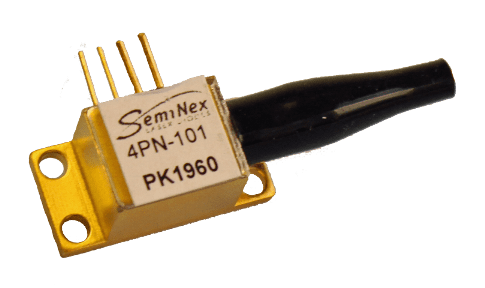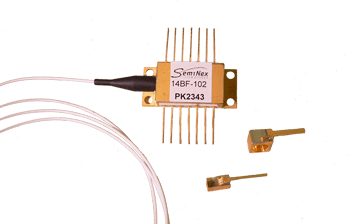An infrared laser is a low cost, high power laser with many capabilities. These lasers are small and light, allowing for operation without a high input power requirement.
Infrared light is radiation in the non-visible spectrum, which extends from 1300 to 1700 nm. Lasers in this range emit radiation in the “eye safe” part of the electromagnetic spectrum, where light is largely absorbed by the cornea and lens, without reaching the retina. Please note that all lasers can cause harm and should be handled with care.
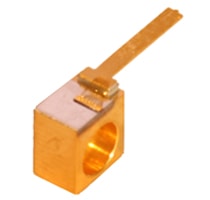
Different wavelengths of infrared light serve different purposes. Infrared lasers with wavelengths of 1310nm, 1550nm, and 1625nm are ideal for fiber optic communications, whereas infrared lasers of 1480nm function well as pumps for optical amplifiers. However, there are other applications for infrared laser light as well.
The Electromagnetic Spectrum with Applications for Infrared Diode Lasers
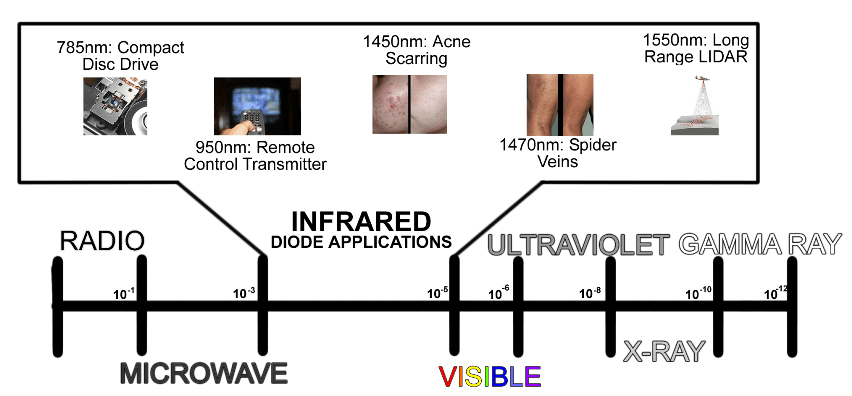
SemiNex Corporation makes and distributes infrared lasers, which are ideal for medical applications such as acne removal, skin wrinkle reduction, and skin ablation and can also be used in a range of professional laser applications in the medical industry, in free-space communications, for military applications, and in range finding.
FREE SPACE OPTICS
Many people don’t realize they use laser technology daily. In ancient times, the Greeks communicated via polished shields to send signals in battle. In modern times, shiny shield technology has unfortunately become obsolete, but free space optics live on most commonly in remote controls. Infrared lasers are placed inside the remote and emit binary-encoded pulses to signal when different buttons have been pressed. This is why you must have a clear path between the remote and your TV’s receiver for the remote control to work.
Free space optical communication is the transfer of data between two points with light as the transmission tool. When a laser diode with an infrared wavelength is used in free-space optical communications, the laser light’s invisibility prevents interference and has a low divergence (light does not ‘spread’ as it travels).
Try This At Home!
Take your cell phone and get ready to take a picture. Hold down any button on the remote while aiming it at the camera and take a picture with your cell phone. See the light coming out of the end of the remote in the picture? That’s infrared light at work using LED’s!

INFRARED LIGHT AND THE MILITARY
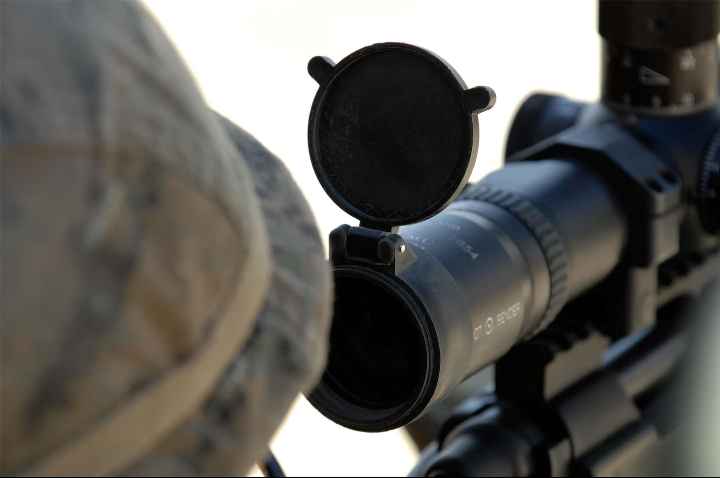
Infrared lasers are popular with the military for targeting. In the military, infrared lasers are primarily used as laser target designators, which are used with precision-guided munitions to guide munitions. An infrared laser is favored when directing munitions at live targets because light from an infrared laser cannot be seen by the human eye.
TEMPERATURE MEASUREMENT USING INFRARED LASERS
Infrared lasers can also be used in temperature measuring. Devices can aim infrared laser light at an object and measure the electromagnetic radiation emitted from the object’s surface. This is useful in situations where a contact-digital-thermometer would be dangerous or difficult to use, such as measuring the temperature of a car’s engine or of food on a grill.
INFRARED DIODES AND NONABLATIVE FACIALS
Infrared lasers can also be used for medical purposes. The treatment and reduction of acne, acne scars, wrinkles, and rosacea are the most popular targets for non-ablative facial treatments with diode lasers. Acne procedures destroy the sebaceous glands responsible for oil production and can help those with moderate to severe acne enjoy clear skin. Other treatments aim for collagen production by destroying dermis cells. As the cells repair themselves, collagen production is increased, giving skin a fuller, healthier look.

Unlike Ablative Facials, which completely remove the epidermis causing swelling and crusty scabs and require at least a week of recovery, there is very little pain associated with nonablative procedures and virtually no downtime.
Visit the Products Page for more information on SemiNex’s product offerings.

